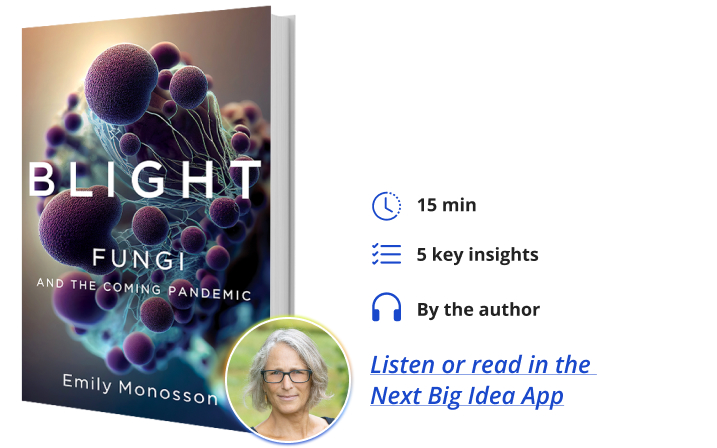Emily Monosson is an environmental toxicologist with a Ph.D. in Toxicology from Cornell University. She is an adjunct faculty at the University of Massachusetts and a research scholar at the Ronin Institute. Below, Emily shares 5 key insights from her new book, Blight: Fungi and the Coming Pandemic. Listen to the audio version—read by Emily herself—in the Next Big Idea App.

1. Fungi are amazing.
Fungi are so much more than molds and mushrooms. The diversity of the Fungal Kingdom is staggering. That kingdom includes some of the most important decomposers, and species which are essential for healthy ecosystems. In short, fungi are essential for life on Earth, and several are also good to eat.
Fungi are complex organisms that can evolve to evade antifungal medication, tolerate warmer temperatures, or inhabit novel environments. The spores of some species can last in soil for decades. Some can travel far, across fields, forests, and even oceans.
While these pathogens represent only a small proportion of all fungi, when they occur, the outcome can be devastating. Since the emergence of a fungus called Pd in the 2000s, millions of bats in the eastern U.S. have died, and it has since spread across the country. A different, aquatic fungus has driven dozens of frog species into extinction and threatened hundreds of others. Another fungus is killing whitebark pine, an iconic tree already living on the edge, above the tree line. A century ago, a fungus wiped out the American chestnut tree, turning a tree that once dominated the forest overstory into shrubby understory. Perhaps most at risk are our food crops: bananas, wheat, rice, and other staple foods that can quickly be destroyed by fungus. There are few other microbes that are so destructive.
2. Fungal infections are on the rise in humans.
Compared with other pathogens, like disease-causing bacteria or viruses, really bad fungal infections are relatively rare in humans. However, when a fungus causes a systemic infection, depending on the fungus and the patient, it can be difficult to diagnose, hard to treat, and the mortality rate can be as high as 30 to 50 percent or more. Each year fungal infections cause over 1.5 million deaths, over 100 million severe infections, and many more people seek medical attention for less severe fungal infections.
We humans have at least three major protections against most fungal pathogens: our warm bodies; our robust immune system; and our microbiome. However, over the past half century or so we have become increasingly susceptible to fungal infections. Antibiotics can upset our microbiome and many life-saving drugs for cancer treatments, organ transplants, and HIV can suppress our immune system.
“Each year fungal infections cause over 1.5 million deaths.”
As the environment warms, some fungi may evolve to tolerate warmer temperatures; some may even evolve to tolerate our temperature range. It would not be surprising if new kinds of fungal infections emerge in humans, or for established fungi to become more widespread. There is a dangerous yeast called Candida auris. Those most susceptible to this fungus are often already in the hospital or in long-term care facilities. It emerged less than a dozen years ago and is spreading across the country. Some strains emerged already resistant to antifungal medications, so it can be difficult to treat and can have a high mortality rate. Candida auris can be spread through contact, which is unusual for a fungus, and it is one of the 19 fungi listed by the World Health Organization in 2022 as a priority fungal pathogen.
3. Preserving genetic diversity is critical.
Most scientists agree that a species’ best chance of survival against a new fungal pathogen is genetic diversity. There is the hope that some members of a species might carry within their genome some kind of resistance. This may be true for bats under threat from white-nose disease and trees that manage to survive pine blister rust, along with other species under threat. Therefore, it is important that we work toward the preservation of genetic diversity in wild animals, trees, and crops.
4. The work we don’t see can give us hope.
What we seldom see when reading about deadly fungi or bats or bananas or frogs is the collective passion of scientists working to solve problems, like fungal pandemics. There are scientists working to save iconic and increasingly rare pine trees, others who are learning how bat populations might survive white-nose disease, and others protecting salamanders in the U.S. from a fungus that is infecting and killing salamanders in Europe. Then there are the scientists tracking emergent fungal pathogens in humans; we don’t often see them or hear about them, but collectively their work gives hope.
5. We are responsible for our own future.
When a disease-causing fungus emerges as a novel fungal pathogen, its arrival can often be traced back to something humans have done. We move fungi from their native hosts and locales to new places and provide them with an opportunity to infect new hosts. If we practice prevention, if we are more careful, and have more regulations around the transport of plants and animals around the world, we may reduce the introduction of at least some novel fungal pathogens. Preventing new outbreaks through greater awareness and by supporting prevention policies and regulation is our collective responsibility.
To listen to the audio version read by author Emily Monosson, download the Next Big Idea App today:































